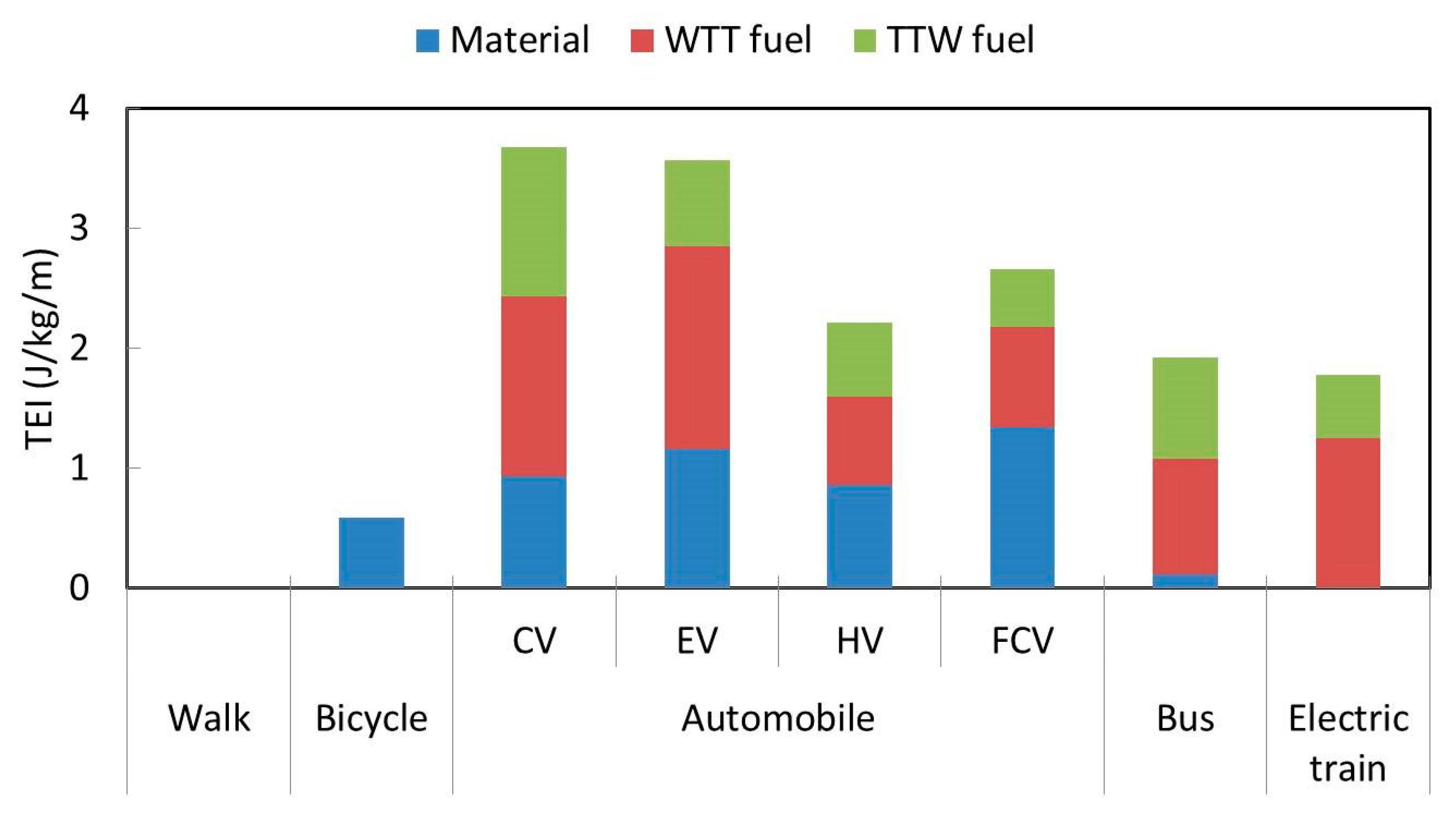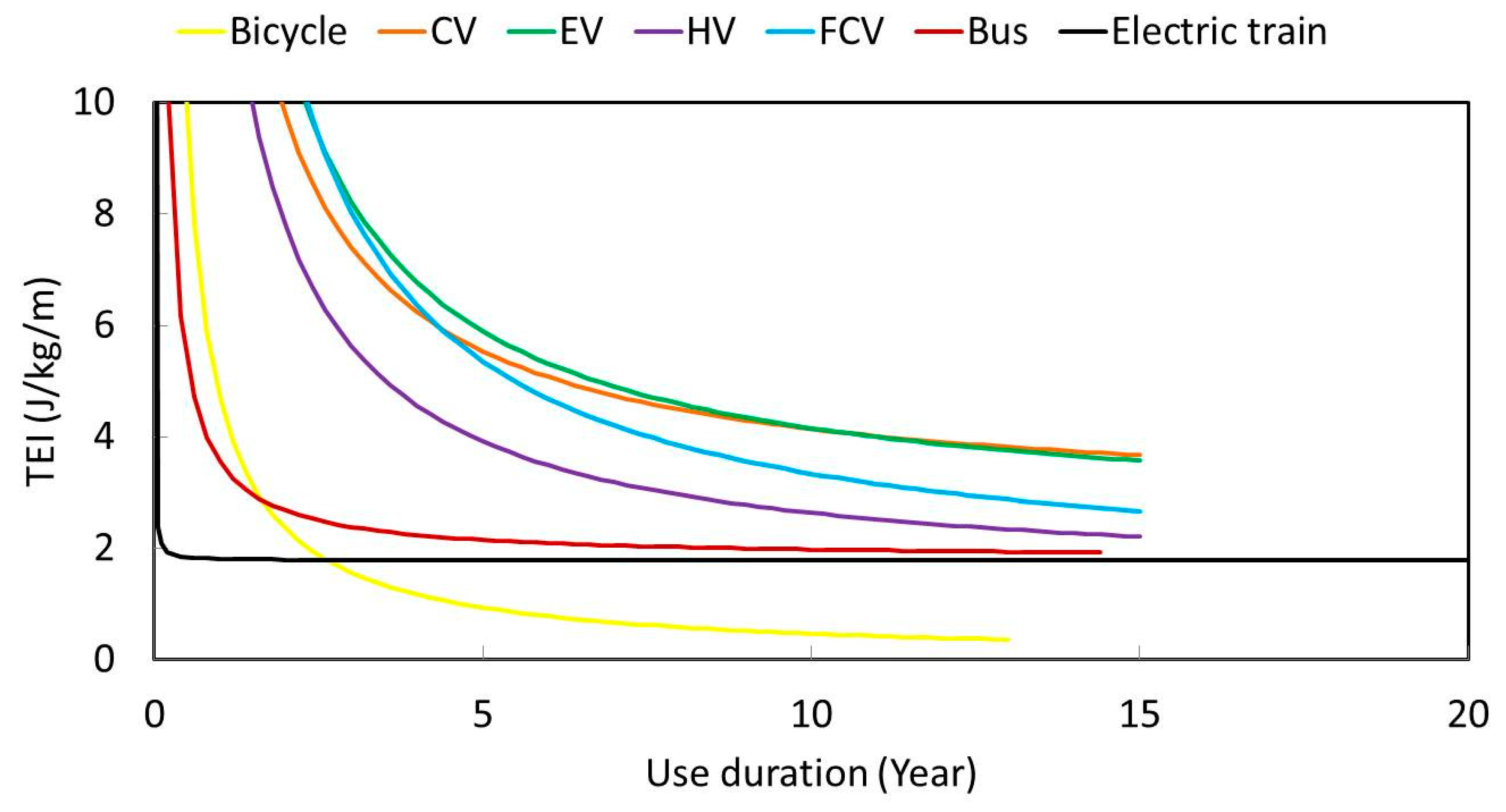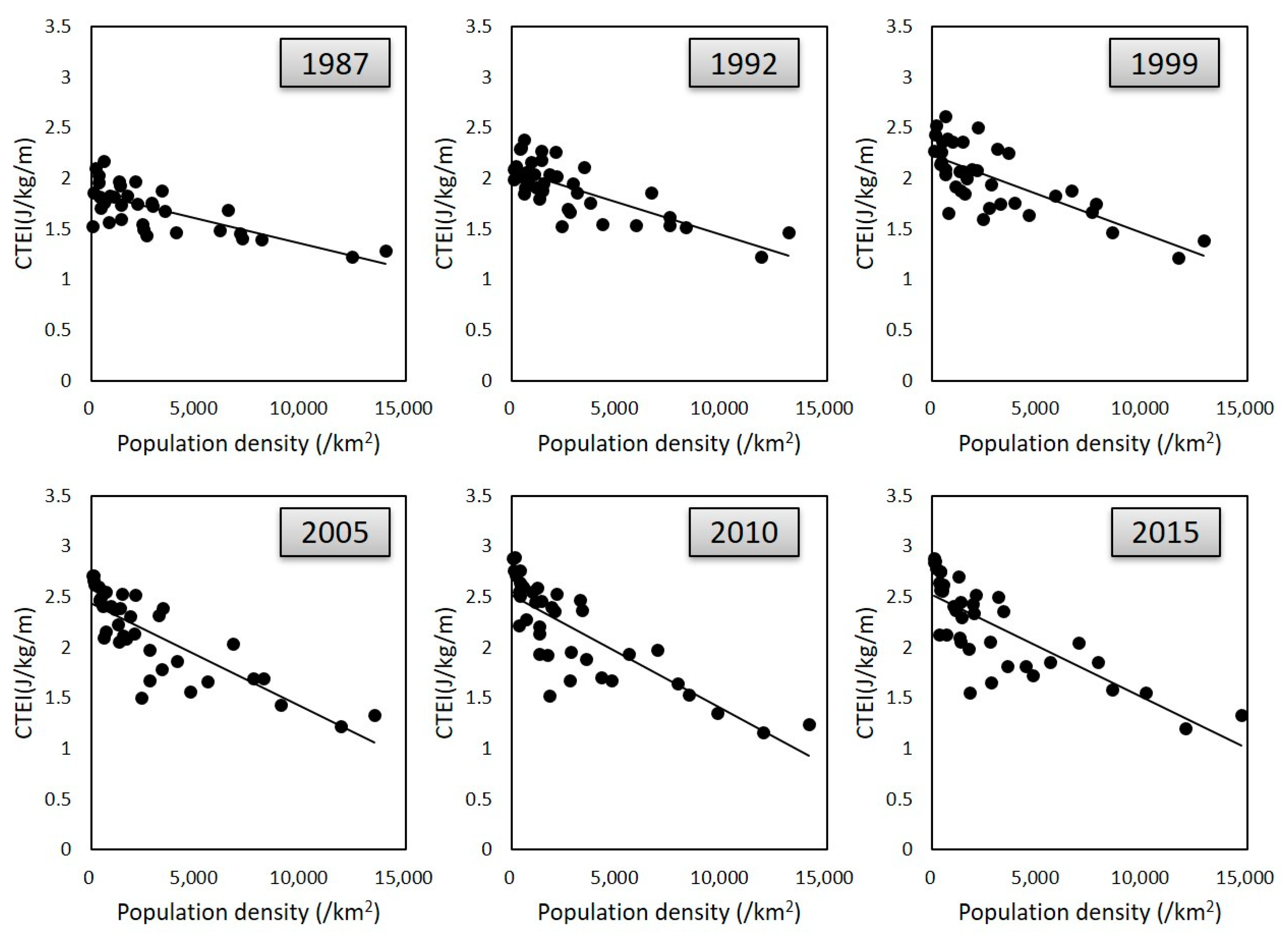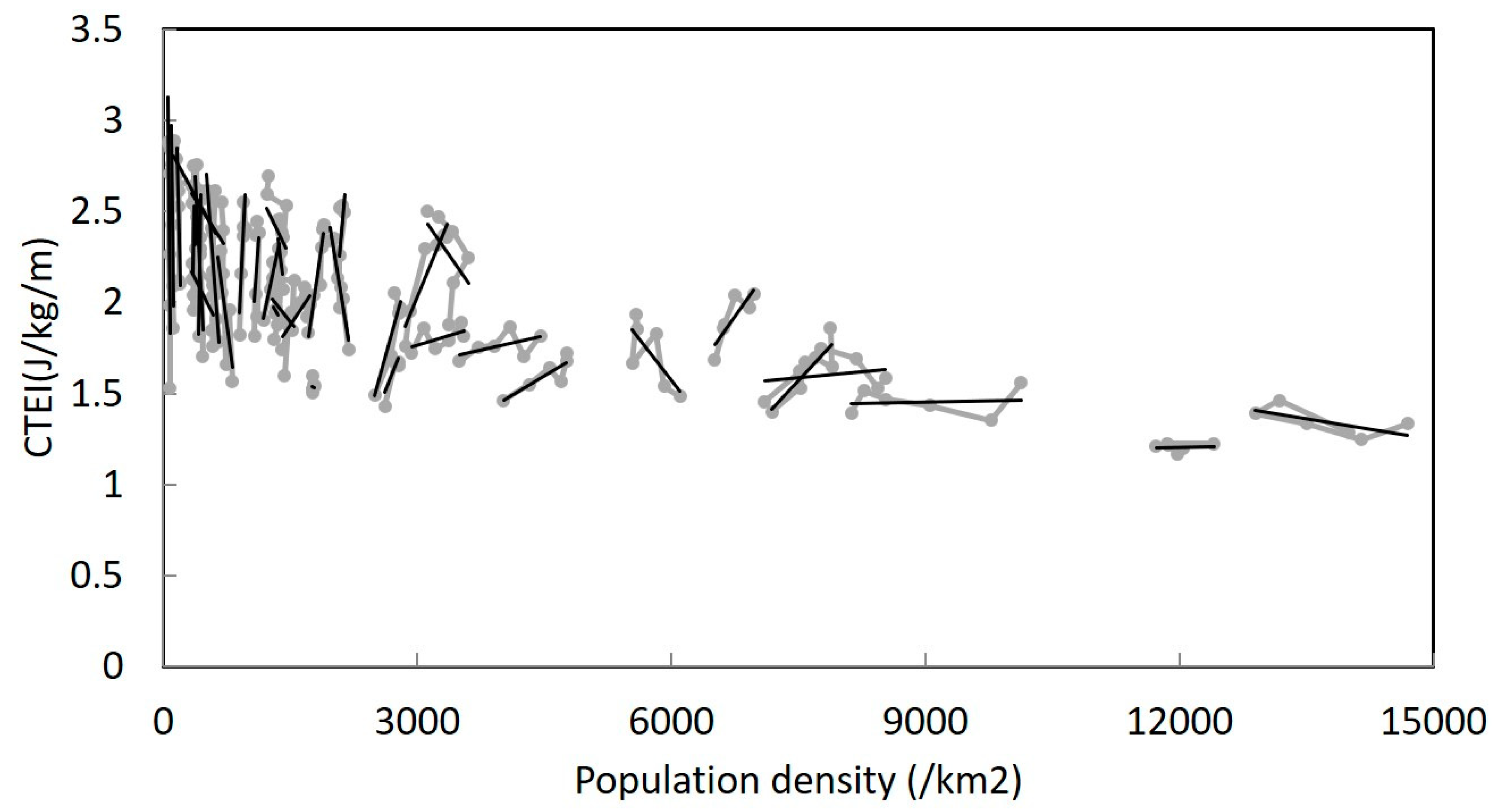Chronological Transition of Relationship between Intracity Lifecycle Transport Energy Efficiency and Population Density
Abstract
1. Introduction
2. Materials and Methods
2.1. Boundary of Energy Consumption
2.2. Transporation Mode
2.3. Intracity Transport Energy Efficiency
2.4. Data Collection
3. Transport Energy Intensity for Each of the Transportation Means
4. Relationship between Intracity Transport Energy Intensity and Population Density by Year
5. Discussion
6. Conclusions
- Transport energy intensity decreases in the order of automobiles, buses, electric trains, bicycles and walks.
- For small-scale transportation means including bicycles and automobiles, energy consumption for the material structure has a great contribution to determining the transport energy intensity.
- Material structure hardly affects the transport energy intensity for large-scale transportation means including buses and electric trains.
- The greater level of population density is associated with the lower intracity transport energy intensity in Japanese cities, as seen in earlier studies with a focus on other spatial scopes.
- The negative slope of its regression line between intracity transport energy intensity and population density increases over time in 1987–2015.
Author Contributions
Funding
Conflicts of Interest
Appendix A
| City | Year | |||||
|---|---|---|---|---|---|---|
| 1987 | 1992 | 1999 | 2005 | 2010 | 2015 | |
| Sapporo | 1.74 | 1.95 | 1.99 | 2.08 | 1.92 | 1.99 |
| Hirosaki | 1.83 | 2.05 | 2.39 | 2.55 | 2.54 | 2.64 |
| Morioka | 1.76 | 1.84 | 2.03 | 2.10 | 2.22 | 2.12 |
| Sendai | 1.77 | 1.90 | 2.07 | 2.22 | 2.21 | 2.30 |
| Shiogama | 1.88 | 2.10 | 2.25 | 2.39 | 2.47 | 2.50 |
| Yuzawa | 1.53 | 1.98 | 2.27 | 2.71 | 2.88 | 2.88 |
| Koriyama | 1.82 | 2.30 | 2.36 | 2.49 | 2.61 | 2.56 |
| Utsunomiya | 1.96 | 2.27 | 2.36 | 2.53 | 2.59 | 2.69 |
| Tokorozawa | 1.46 | 1.55 | 1.64 | 1.56 | 1.68 | 1.72 |
| Chiba | 1.72 | 1.86 | 1.74 | 1.79 | 1.89 | 1.82 |
| Matsudo | 1.40 | 1.53 | 1.67 | 1.69 | 1.65 | 1.86 |
| Tokyo | 1.29 | 1.46 | 1.39 | 1.33 | 1.24 | 1.33 |
| Yokohama | 1.46 | 1.62 | 1.75 | 1.69 | 1.53 | 1.58 |
| Kawasaki | 1.39 | 1.51 | 1.47 | 1.43 | 1.35 | 1.56 |
| Yamanashi | 2.17 | 2.38 | 2.61 | 2.66 | 2.89 | 2.85 |
| Kanazawa | 1.82 | 2.15 | 2.36 | 2.41 | 2.55 | 2.40 |
| Gifu | 1.97 | 2.25 | 2.50 | 2.51 | 2.53 | 2.52 |
| Nagoya | 1.68 | 1.86 | 1.87 | 2.04 | 1.97 | 2.05 |
| Kasugai | 1.76 | 1.95 | 2.29 | 2.31 | 2.37 | 2.36 |
| Kyoto | 1.54 | 1.52 | 1.60 | 1.50 | 1.52 | 1.55 |
| Uji | 1.49 | 1.70 | 1.94 | 1.97 | 1.95 | 2.05 |
| Osaka | 1.22 | 1.23 | 1.21 | 1.22 | 1.16 | 1.20 |
| Sakai | 1.48 | 1.54 | 1.83 | 1.66 | 1.93 | 1.85 |
| Kobe | 1.43 | 1.66 | 1.71 | 1.67 | 1.67 | 1.65 |
| Nara | 1.60 | 1.80 | 1.88 | 2.05 | 1.94 | 2.10 |
| Kainan | 1.78 | 1.91 | 2.09 | 2.40 | 2.59 | 2.61 |
| Matsue | 1.96 | 2.04 | 2.14 | 2.60 | 2.63 | 2.75 |
| Yasugi | 1.86 | 2.09 | 2.43 | 2.71 | 2.76 | 2.84 |
| Hiroshima | 1.60 | 1.88 | 1.85 | 2.12 | 2.13 | 2.06 |
| Kure | 1.57 | 1.96 | 1.66 | 2.16 | 2.28 | 2.13 |
| Tokushima | 1.93 | 2.18 | 2.07 | 2.38 | 2.46 | 2.45 |
| Imabari | 1.70 | 2.02 | 2.26 | 2.47 | 2.51 | 2.57 |
| Kochi | 1.81 | 2.04 | 1.92 | 2.38 | 2.44 | 2.37 |
| Nankoku | 2.03 | 2.29 | 2.16 | 2.47 | 2.76 | 2.75 |
| Kitakyusyu | 1.74 | 2.02 | 2.08 | 2.13 | 2.35 | 2.34 |
| Fukuoka | 1.68 | 1.75 | 1.76 | 1.87 | 1.70 | 1.82 |
| Kumamoto | 1.83 | 2.04 | 2.09 | 2.30 | 2.40 | 2.42 |
| Hitoyoshi | 2.10 | 2.12 | 2.52 | 2.61 | 2.71 | 2.78 |
References
- Parshall, L.; Gurney, K.; Hammer, S.A.; Mendoza, D.; Zhou, Y.; Geethakumar, S. Modeling energy consumption and CO2 emissions at the urban scale, methodological challenges and insights from the United States. Energy Policy 2010, 38, 4765–4782. [Google Scholar] [CrossRef]
- Dulal, H.B.; Brodnig, G.; Onoriose, C.G. Climate change mitigation in the transport sector through urban planning: A review. Habitat Int. 2011, 35, 494–500. [Google Scholar] [CrossRef]
- Kennedy, C.; Baker, L.; Dhakal, S.; Ramaswami, A. Sustainable urban systems. J. Ind. Ecol. 2012, 16, 775–779. [Google Scholar] [CrossRef]
- Bulkeley, H.; Broto, V.C.; Maassen, A. Low carbon transitions and the reconfiguration of urban infrastructure. Urban Stud. 2014, 51, 1471–1486. [Google Scholar] [CrossRef]
- Rutherford, J.; Jaglin, S. Introduction to the special issue-Urban energy governance: Local actions, capacities and politics. Energy Policy 2015, 78, 173–178. [Google Scholar] [CrossRef]
- Ma, J.; Liu, Z.; Chai, Y. The impact of urban form on CO2 emission from work and non-work trips: The case of Beijing, China. Habitat Int. 2015, 47, 1–10. [Google Scholar] [CrossRef]
- Wang, Y.; Yang, L.; Han, S.; Li, C.; Ramachandra, T.V. Urban CO2 emissions in Xi’an and Bangalore by commuters: Implications for controlling urban transportation carbon dioxide emissions in developing countries. Mitig. Adapt. Strateg. Glob. Chang. 2017, 22, 993–1019. [Google Scholar] [CrossRef]
- Brand, C.; Tran, M.; Anable, J. The UK transport carbon model: An integrated life cycle approach to explore low carbon futures. Energy Policy 2012, 41, 107–124. [Google Scholar] [CrossRef]
- IEA. Technology Roadmap. Fuel Economy of Road Vehicles; Technical Report; International Energy Agency: Paris, France, 2012. [Google Scholar]
- Osorio, C.; Nanduri, K. Energy-Efficient Urban Traffic Management: A Microscopic Simulation-Based Approach. Transp. Sci. 2015, 49, 637–651. [Google Scholar] [CrossRef]
- Zhao, P.J.; Diao, J.J.; Li, S.X. The influence of urban structure on individual transport energy consumption in China’s growing cities. Habitat Int. 2017, 66, 95–105. [Google Scholar] [CrossRef]
- Cao, X.; Yang, W. Examining the effects of the built environment and residential self-selection on commuting trips and the related CO2 emissions: An empirical study in Guangzhou, China. Transp. Res. Part D Transp. Environ. 2017, 52, 480–494. [Google Scholar] [CrossRef]
- Hughes, B.; Chambers, L.; Lansdell, H.; White, R. Cities, area and transport energy. Road Transp. Res. 2004, 13, 72. [Google Scholar]
- Newman, P.W.G.; Kenworthy, J.R. Gasoline Consumption and Cities: A comparison of U.S. Cities with a Global Survey. J. Am. Plan. Assoc. 1989, 55, 24–37. [Google Scholar] [CrossRef]
- Muniz, I.; Galindo, A. Urban form and the ecological footprint of commuting: The case of Barcelona. Ecol. Econ. 2005, 55, 499–514. [Google Scholar] [CrossRef]
- Newman, P. The environmental impact of cities. Environ. Urban. 2006, 18, 275–295. [Google Scholar] [CrossRef]
- Shim, G.E.; Rhee, S.M.; Ahn, K.H.; Chung, S.B. The relationship between the characteristics of transportation energy consumption and urban form. Ann. Reg. Sci. 2006, 40, 351–367. [Google Scholar] [CrossRef]
- Alford, G.; Whiteman, J. Macro-urban form and transport energy outcomes: Investigations for Melbourne. Road Transp. Res. 2009, 18, 53–67. [Google Scholar]
- Brownstone, D.; Golob, T.F. The impact of residential density on vehicle usage and energy consumption. J. Urban Econ. 2009, 65, 91–98. [Google Scholar] [CrossRef]
- Hankey, S.; Marshall, J.D. Impacts of urban form on future US passenger-vehicle greenhouse gas emissions. Energy Policy 2010, 38, 4880–4887. [Google Scholar] [CrossRef]
- Karathodorou, N.; Graham, D.; Noland, R. Estimating the effect of urban density on fuel demand. Energy Econ. 2010, 32, 86–92. [Google Scholar] [CrossRef]
- Su, Q. The effect of population density, road network density, and congestion on household gasoline consumption in U.S. urban areas. Energy Econ. 2011, 33, 445–452. [Google Scholar] [CrossRef]
- Clark, T.A. Metropolitan density, energy efficiency and carbon emissions: Multi-attribute tradeoffs and their policy implications. Energy Policy 2013, 53, 413–428. [Google Scholar] [CrossRef]
- Modarres, A. Commuting and energy consumption: Toward an equitable transportation policy. J. Transp. Geogr. 2013, 33, 240–249. [Google Scholar] [CrossRef]
- Aguiléra, A.; Voisin, M. Urban form, commuting patterns and CO2 emissions: What differences between the municipality’s residents and its jobs? Transp. Res. Part A Policy Pract. 2014, 69, 243–251. [Google Scholar] [CrossRef]
- Yang, W.; Li, T.; Cao, X. Examining the impacts of socio-economic factors, urban form and transportation development on CO2 emissions from transportation in China: A panel data analysis of China’s provinces. Habitat Int. 2015, 49, 212–220. [Google Scholar] [CrossRef]
- Fiori, C.; Ahn, K.; Rakha, H.A. Power-based electric vehicle energy consumption model: Model development and validation. Appl. Energy 2016, 168, 257–268. [Google Scholar] [CrossRef]
- Kosai, S.; Nakanishi, M.; Yamasue, E. Vehicle Energy Efficiency Evaluation from Well-to Wheel Lifecycle Perspective. Transp. Res. Part D Transp. Environ. 2018, 65, 355–367. [Google Scholar] [CrossRef]
- Zhang, B.; Sarathy, S.M. Lifecycle optimized ethanol-gasoline blends for turbocharged engines. Appl. Energy 2016, 181, 38–53. [Google Scholar] [CrossRef]
- Hawkins, T.R.; Gausen, O.M.; Strømman, A.H. Environmental impacts of hybrid and electric vehicles—A review. Int. J. Life Cycle Assess. 2012, 17, 997–1014. [Google Scholar] [CrossRef]
- Casals, L.C.; Martinez-Laserna, E.; Garcia, B.A.; Nieto, N. Sustainability analysis of the electric vehicle use in Europe for CO2 emissions reduction. J. Clear. Prod. 2016, 127, 425–437. [Google Scholar] [CrossRef]
- Larsson, M.; Mohseni, F.; Wallmark, C.; Gronkvist, S.; Alvfors, P. Energy system analysis of the implications of hydrogen fuel cell vehicles in the Swedish road transport system. Int. J. Hydrog. Energy 2015, 40, 11722–11729. [Google Scholar] [CrossRef]
- Washing, E.M.; Pulugurtha, S.S. Well-to-Wheel Analysis of Electric and Hydrogen Light Rail. J. Public Transp. 2015, 18, 74–88. [Google Scholar] [CrossRef][Green Version]
- Baptista, P.; Pina, A.; Duarte, G.; Rolim, C.; Pereira, G.; Silva, C.; Farias, T. From on-road trial evaluation of electric and conventional bicycles to comparison with other urban transport modes: Case study in the city of Lisbon, Portugal. Energy Convers. Manag. 2015, 92, 10–18. [Google Scholar] [CrossRef]
- Facanha, C.; Horvath, A. Evaluation of life-cycle air emission factors for freight transportation. Environ. Sci. Technol. 2007, 41, 7138–7144. [Google Scholar] [CrossRef]
- Schipper, L.; Saenger, C.; Sudarshan, A. Transport and Carbon Emission in the United States: The Long View. Energies 2011, 2011, 563–581. [Google Scholar] [CrossRef]
- Kamakaté, F.; Schipper, L. Trends in truck freight energy use and carbon emissions in selected OECD countries from 1973 to 2005. Energy Policy 2009, 37, 3743–3751. [Google Scholar] [CrossRef]
- Mendiluce, M.; Schipper, L. Trends in passenger transport and freight energy use in Spain. Energy Policy 2011, 39, 6466–6475. [Google Scholar] [CrossRef]
- de Witte, A.; Hollevoet, J.; Dobruszkes, F.; Hubert, M.; Macharis, C. Linking modal choice to motility: A comprehensive review. Transp. Res. Part A Policy Pract. 2013, 49, 329–341. [Google Scholar] [CrossRef]
- Limtanakool, N.; Dijst, M.; Schwanen, T. The influence of socioeconomic characteristics, land use and travel time considerations on mode choice for medium- and longer-distance trips. J. Transp. Geogr. 2006, 14, 327–341. [Google Scholar] [CrossRef]
- Waygood, E.O.D.; Sun, Y.L.; Susilo, Y.O. Transportation carbon dioxide emissions by built environment and family lifecycle: Case study of the Osaka metropolitan area. Transp. Res. Part D Transp. Environ. 2014, 31, 176–188. [Google Scholar] [CrossRef]
- Burnham, A.; Wang, M.; Wu, Y. Development and Applications of GREET 2.7—The Transportation Vehicle-cycle Model; ANL/ESD/06-5; Center for Transportation Research, Argonne National Laboratory: Argonne, IL, USA, 2006. [Google Scholar]
- Chester, M.V.; Horvath, A.; Madanat, S. Comparison of life-cycle energy and emissions footprints of passenger transportation in metropolitan regions. Atmos. Environ. 2010, 44, 1071–1079. [Google Scholar] [CrossRef]
- Sullivan, J.L.; Burnham, A.; Wang, M.Q. Model for the Part Manufacturing and Vehicle Assembly Component of the Vehicle Life Cycle Inventory. J. Ind. Ecol. 2013, 17, 143–153. [Google Scholar] [CrossRef]
- Chung, W.; Zhou, G.; Yeung, I.M.H. A study of energy efficiency of transport sector in China from 2003 to 2009. Appl. Energy 2013, 112, 1066–1077. [Google Scholar] [CrossRef]
- Lipscy, P.Y.; Schipper, L. Energy efficiency in the Japanese transport sector. Energy Policy 2013, 56, 248–258. [Google Scholar] [CrossRef]
- Japan Environmental Management Association for Industry. JEMAI-LCA Pro. Available online: http://www.jemai.or.jp/ (accessed on 12 May 2017).
- Japan Automobiles Research Institute. Overall Efficiency and GHG Emissions. Available online: http://www.jari.or.jp/Portals/0/jhfc/data/report/2010/pdf/result.pdf (accessed on 14 February 2018). (In Japanese).
- Kudo, Y.; Ishitani, H.; Matsuhashi, R. Kokyo yuso kikan no raifu saikuru CO2 haishutsu tokusei no kensho. KeiO Associated Repository of Academia Resources. AA12113622-00000116-0001. 2007. Available online: https://core.ac.uk/download/pdf/56669183.pdf (accessed on 21 February 2020). (In Japanese).
- Oki, Y. Survey on Energy Saving in the Steel Products. Available online: http://eneken.ieej.or.jp/data/pdf/468.pdf (accessed on 9 August 2017). (In Japanese).
- Ministry of Land, Infrastructure and Transport. Transport and City Planning Report. Available online: http://www.mlit.go.jp/toshi/tosiko/toshi_tosiko_fr_000024.html (accessed on 18 February 2018). (In Japanese)
- Statistics Japan. Population Statistics; Ministry of Internal Affairs and Communications: Tokyo, Japan. (In Japanese)
- Liedl, G.; Bielak, R.; Ivanova, J.; Enzinger, N.; Figner, G.; Bruckner, J.; Pasic, H.; Pudar, M.; Hampel, S. Joining of Aluminum and Steel in Car Body Manufacturing. Phys. Procedia 2011, 12, 150–156. [Google Scholar] [CrossRef]
- Japan Auminum Can Recycling Association. Recyling. Available online: http://www.alumi-can.or.jp/publics/index/24/ (accessed on 8 September 2018).
- COSMO RECYCLE CO., Ltd. Iron Scap Recycling. Available online: http://www.cosmorecycle.com/english/ (accessed on 6 September 2018).
- Ministry of Environmnet. Annual Report on the Environment, the Sound Material-Cycle Society and the Biodiversity in Japan. Available online: http://www.env.go.jp/en/wpaper/2017/pdf/2017_all.pdf (accessed on 10 December 2017).
- Bai, J.; Li, Y.; Zuo, W. Cross-sectional shape optimisation for thin-walled beam crashworthiness with stamping constraints using genetic algorithm. Int. J. Veh. Des. 2017, 73, 76–95. [Google Scholar] [CrossRef]
- Nuss, P.; Eckelman, M.J. Life Cycle Assessment of Metals: A Scientific Synthesis. PLoS ONE 2014, 9, e101298. [Google Scholar] [CrossRef]
- Graedel, T.E.; Harper, E.M.; Nassar, N.T.; Nuss, P.; Reck, B.K. Criticality of metals and metalloids. PNAS 2015, 112, 4257–4262. [Google Scholar] [CrossRef]
- Kosai, S.; Hashimoto, S.; Matsubae, K.; McLellan, B.; Yamasue, E. Comprehensive Analysis of External Dependency in terms of Material Criticality by Employing Total Material Requirement: Sulfuric Acid Production in Japan as a case study. Minerals 2018, 8, 114. [Google Scholar] [CrossRef]
- Kosai, S.; Unesaki, H. Quantitative Analysis on the Impact of Nuclear Energy Supply Disruption on Electricity Supply Security. Appl. Energy 2017, 208, 1198–1207. [Google Scholar] [CrossRef]
- The Institute of Energy Economics, Japan. Asia/World Energy Outlook. Available online: https://eneken.ieej.or.jp/data/6332.pdf (accessed on 26 November 2017).
- Ministry of Land, Infrastructure and Transport. Grandline 2050: Appendix. Available online: http://www.mlit.go.jp/common/001050896.pdf (accessed on 17 February 2018). (In Japanese)
- Ministry of Land, Infrastructure and Transport. Analysis of Current Transport Trend in Japan. Available online: http://www.mlit.go.jp/road/ir/kihon/26/1-1_s1.pdf (accessed on 11 January 2018). (In Japanese)
- Ministry of Internal Affairs and Communications. WHITE PAPER Information and Communications in Japan; Ministry of Internal Affairs and Communications: Tokyo, Japan, 2016.
- Chan, N.D.; Shaheen, S. Ridesharing in North America: Past, present, and future. Transp. Rev. 2012, 32, 93–112. [Google Scholar] [CrossRef]
- Cervero, R.; Tsai, Y.S. City CarShare in San Francisco, California—Second-year travel demand and car ownership impacts. Transp. Res. Rec. 2004, 1887, 117–127. [Google Scholar] [CrossRef]
- National Police Agency. White Paper on Police. Available online: https://www.npa.go.jp/hakusyo/h29/english/full_text_WHITE_PAPER_2017_E.pdf (accessed on 17 October 2019).
- Nationl Institute Population and Social Security Research. Population Projections for Japan. Available online: http://www.ipss.go.jp/pp-zenkoku/j/zenkoku2017/pp29_gaiyou.pdf (accessed on 5 March 2018).
- Ministry of Land, Infrastructure, Transport and Tourism. Human Mobility in City. Available online: https://www.mlit.go.jp/common/001032141.pdf (accessed on 9 July 2019). (In Japanese)
- Ruzzenenti, F.; Basosi, R. Evaluation of the energy efficiency evolution in the European road freight transport sector. Energy Policy 2009, 37, 4079–4085. [Google Scholar] [CrossRef]




| Transportation Mode | Transportation Means | Fuel Type |
|---|---|---|
| Road | Walk | - |
| Bicycle | - | |
| Automobile | ||
| Conventional vehicle (CV) | Gasoline | |
| Electric vehicle (EV) | Electricity | |
| Hybrid vehicle (HV) | Gasoline | |
| Fuel cell vehicle (FCV) | Hydrogen | |
| Bus | Light diesel | |
| Urban rail | Electric train | Electricity |
| Subscript/Abbreviation | Definition | Unit |
|---|---|---|
| Transport energy intensity of each transportation means | J/kg/m | |
| Intracity transport energy intensity | J/kg/m | |
| Energy consumption during the manufacture phase | MJ | |
| WTW Energy consumption during the operational phase per year | MJ/year | |
| WTT energy consumption during the operational phase per year | MJ/year | |
| TTW energy consumption during the operational phase pear year | MJ/year | |
| Fuel economy | km/L, km/kWh | |
| Operation duration | years | |
| Weight of both transportation mean and passenger | kg | |
| Weight of transportation mean | kg | |
| Maximum capacity | Person | |
| Average vehicle occupancy | % | |
| Average traveled distance per year | km/year | |
| Composition rate | % | |
| Energy consumption rate | MJ/kg | |
| Calorific value | MJ/L, MJ/kWh | |
| Fuel production rate | MJ/MJ | |
| Modal split in a given city | % | |
| Composition of transportation means | - | |
| Fuel type | - | |
| Transportation means | - | |
| Assessed year |
| Year | R2 | Regression Coefficient |
|---|---|---|
| 1987 | 0.520 | −4.93 × 105 |
| 1992 | 0.583 | −6.49 × 105 |
| 1999 | 0.540 | −7.71 × 105 |
| 2005 | 0.666 | −1.02 × 104 |
| 2010 | 0.668 | −1.12 × 104 |
| 2015 | 0.617 | −1.01 × 104 |
© 2020 by the authors. Licensee MDPI, Basel, Switzerland. This article is an open access article distributed under the terms and conditions of the Creative Commons Attribution (CC BY) license (http://creativecommons.org/licenses/by/4.0/).
Share and Cite
Kosai, S.; Yuasa, M.; Yamasue, E. Chronological Transition of Relationship between Intracity Lifecycle Transport Energy Efficiency and Population Density. Energies 2020, 13, 2094. https://doi.org/10.3390/en13082094
Kosai S, Yuasa M, Yamasue E. Chronological Transition of Relationship between Intracity Lifecycle Transport Energy Efficiency and Population Density. Energies. 2020; 13(8):2094. https://doi.org/10.3390/en13082094
Chicago/Turabian StyleKosai, Shoki, Muku Yuasa, and Eiji Yamasue. 2020. "Chronological Transition of Relationship between Intracity Lifecycle Transport Energy Efficiency and Population Density" Energies 13, no. 8: 2094. https://doi.org/10.3390/en13082094
APA StyleKosai, S., Yuasa, M., & Yamasue, E. (2020). Chronological Transition of Relationship between Intracity Lifecycle Transport Energy Efficiency and Population Density. Energies, 13(8), 2094. https://doi.org/10.3390/en13082094





